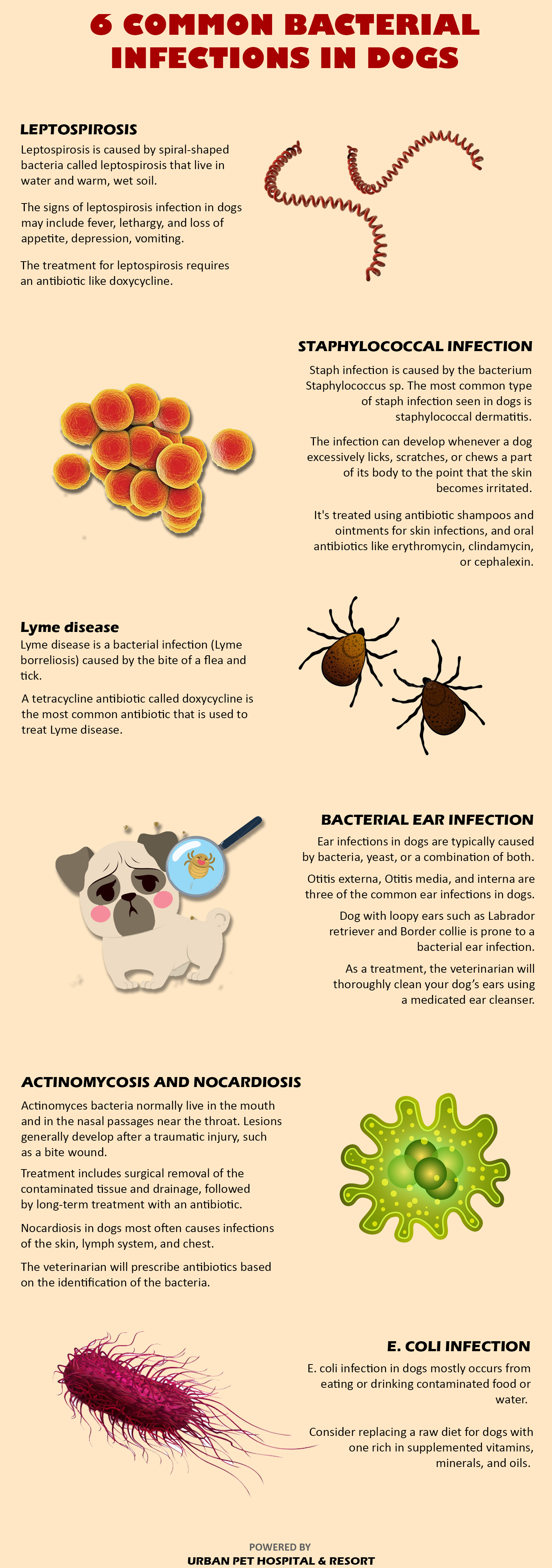
Dogs are susceptible to different types of bacterial and fungal infections. Domestic dogs who wander outside often are more prone to bacterial infection. Most bacterial infections subside when they’re diagnosed and treated on time but it can be fatal or even life-threatening if the treatment is not administered on time.
Here we’ll talk about different types of bacterial infections most common in dogs and how to prevent or treat them.
6 Common Bacterial Infections in Domestic Dogs
Here are the six most common bacterial infections found in dogs.
Leptospirosis

Leptospirosis is caused by spiral-shaped bacteria called leptospirosis that live in water and warm, wet soil. They can also contract it by coming in contact with urine from other animals infected with the bacteria or through bites or from mating with other infected dogs.
The signs of leptospirosis infection in dogs may include fever, lethargy, and loss of appetite, depression, vomiting, and redness of the mucous membranes. In the case of serious infection, dogs can often develop kidney inflammation, which can result in permanent damage to the kidney.
Dogs that regularly wander outside the home are potentially at risk of contracting this disease. Once contracted, it takes about 4-12 days for the bacteria to incubate.
The treatment for leptospirosis requires an antibiotic like doxycycline. It can be administered through the mouth in the form of a tablet, capsule, or liquid. If administering liquid forms, be sure to measure the medication carefully. When administering the tablets, the pill should be followed by at least 6mL of water or food – never give the pill dry.
The four-Serovar vaccine is currently the only vaccine recommended by experts for the prevention of Leptospirosis. Revaccinating annually is often needed to maintain the best immunity
Staphylococcal Infection
Staph infection is caused by the bacterium Staphylococcus sp. The most common type of staph infection seen in dogs is staphylococcal dermatitis, a bacterial skin infection that can cause the skin to become red and inflamed. It lives naturally on the skin of dogs and humans, where it stays dormant as long as the skin is healthy.
The infection can develop whenever a dog excessively licks, scratches, or chews a part of its body to the point that the skin becomes irritated. In other cases, a staph infection can occur in dogs that have fleas or have allergies to certain foods, medications, or environmental factors.
Staph can be transmitted from one dog to another and from humans to dogs. It’s a zoonotic disease.
Some of the common symptoms of a staph infection include
- Patchy fur loss with moist skin, crusting and peeling of skin
- Red and inflamed skin
- Pain
- Excessive itching, chewing or licking
- Pus-filled lesions on the skin
- Infections of the eyes, skin, ears, or respiratory system
Staph infections in dogs are treated using antibiotic shampoos and ointments for skin infections, and oral antibiotics like erythromycin, clindamycin, or cephalexin.
Bacterial Ear Infection

Ear infections in dogs are typically caused by bacteria, yeast, or a combination of both. In puppies, ear mites can also be a source of infection. A dog can develop a bacterial ear infection when there is underlying inflammation, moisture, allergies, Endocrine disorders, autoimmune disorders, Wax buildup, and injury to the ear canal.
Some breeds of dogs are more prone to bacterial infection than others. Dog with loopy ears such as Labrador retriever and Border collie is prone to a bacterial ear infection.
Otitis externa, Otitis media, and interna are three of the common ear infections in dogs.
Common signs of a dog ear infection include
- Head shaking
- scratching at the affected ear
- Dark discharge
- odor
- Redness and swelling of the ear canal
- Pain and itchiness
While a healthy dog usually can defend himself against this bacterium, a dog who has a weakened immune system may find it more difficult.
As a treatment, the veterinarian will thoroughly clean your dog’s ears using a medicated ear cleanser. In cases of severe chronic disease where other treatments have failed, the veterinarian may recommend surgery such as a Total Ear Canal Ablation (TECA) that surgically removes the ear canal, thus removing the diseased tissue and preventing the recurrence of infection.
As a precaution, make sure to thoroughly dry their ears after swimming and bathing to prevent moisture buildup.
Actinomycosis and Nocardiosis

Actinomyces viscosus causes abscesses to form under the skin. Actinomyces bacteria normally live in the mouth and in the nasal passages near the throat. Lesions generally develop after a traumatic injury, such as a bite wound. The most commonly affected locations include the head, neck, thorax, and abdomen. Treatment includes surgical removal of the contaminated tissue and drainage, followed by long-term treatment with an antibiotic.
Nocardiosis in dogs most often causes infections of the skin, lymph system, and chest. It can also spread throughout the body and cause infections in multiple internal organs.
The veterinarian will prescribe antibiotics based on the identification of the bacteria. Nocardial infections are resistant to some types of antibiotics. Treatment must often be continued for 1 to 6 months. Surgery to remove infected tissue may also be appropriate.
Lyme disease

Lyme disease is a bacterial infection (Lyme borreliosis) caused by the bite of a flea and tick. The ticks that carry Lyme disease are especially likely to be found in tall grasses, thick brush, marshes, and woods. They easily jump into your dog’s coat.
The most common signs of Lyme disease include fever, loss of appetite, painful or swollen joints. The treatment includes antibiotics, usually for at least 30 days. A tetracycline antibiotic called doxycycline is the most common antibiotic that is used to treat Lyme disease.
As a preventive measure, you can check for flea and tick collar, vet-approved flea and tick preventive, and a vaccine.
E. coli Infection

E. coli infection in dogs mostly occurs from eating or drinking contaminated food or water. It's a zoological disease that can easily transmit from human to dog and vice versa.
In the case of enterotoxigenic E. coli, these bacteria then produce a toxin that acts against the inside of the infected intestinal tract which results in diarrhea. The common signs of the infection include dehydration, lack of appetite, and vomiting.
Consider replacing a raw diet for dogs with one rich in supplemented vitamins, minerals, and oils. As a preventive measure, you can prevent your dog from eating uncooked or raw food, drinking from potentially contaminated water sources.
Here is the detail information about How to treat bacterial infection in your pets.

Urban Pet Hospital & Resort is the best pet hospital in Des Moines. Our in-house certified veterinarian is always ready to examine and treat your pets for any kind of bacterial and fungal infection.